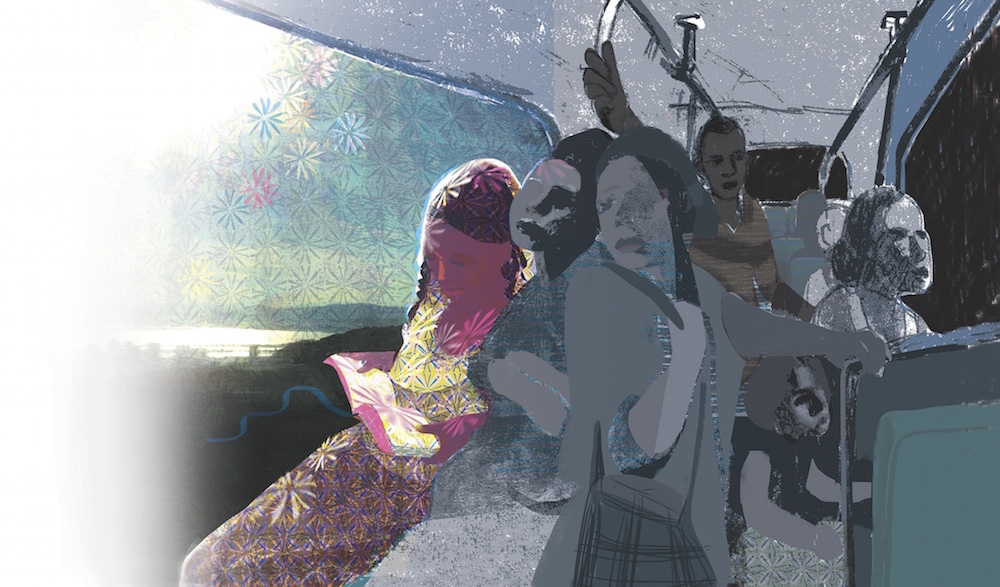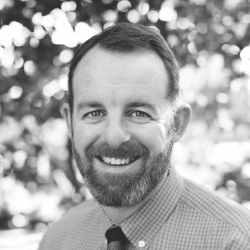
From 2008 to 2015, our family lived six months out of each year in Mwanza, Tanzania, the second largest city in the country, nestled on the southern shores of Lake Victoria. We began spending half the year in Mwanza because my wife, Jen, is an infectious diseases physician-scientist who does clinical medical research on the interaction of a freshwater parasitic infection called schistosomiasis and the HIV virus. Jen holds dual appointments at Weill Cornell Medical College in the United States and its partner institution, Bugando Medical Centre, in Tanzania. Although now with school-aged children we are no longer able to split our time between Pasadena and Mwanza, our family still spends the summer months in northwest Tanzania.
As a New Testament scholar my initial experience in cross-cultural hermeneutics, therefore, came not because of an intentional pursuit on my part, but because I happened to marry someone committed to the field of global health, someone who has lovingly dragged me halfway across the world during sabbaticals and paternity leaves and summer breaks. Yet the experience of reading, teaching, and preaching the Bible in Tanzania has been immensely formational for my own vocation as a seminary professor. In attempting to connect with the local context in Mwanza, I have regularly volunteered as a teacher at St. Paul College, a Pentecostal Bible college and one of the few schools in Tanzania at which pastors and church leaders can receive high-quality theological education. The relationships formed with the leaders and students at St. Paul College, along with my learning in the classroom, have deeply enriched my own understanding of the Bible, my Christian praxis, and even my scholarly research agenda. In this essay I would like to describe one research project, rooted in a commitment to and the experience of cross-cultural hermeneutics, that I would never have imagined when I was getting my PhD in New Testament—but that has generated some of the most rewarding, personally instructive, and, I hope, impactful work of my career to this point.
READING GALATIANS?
It started in the fall of 2009. While we were living in Mwanza, Jen returned from an international conference that focused on emerging strategies for HIV prevention. She mentioned something completely novel to me at the time, namely, that the practice of male circumcision has the potential to save millions of lives by preventing new HIV infections. In the early- to mid-2000s, several large randomized, controlled trials of male circumcision (MC) conducted in South Africa, Kenya, and Uganda had shown an approximately 60 percent reduction in HIV incidence among circumcised heterosexual men.1 The protective effect of MC is thought to occur because of high concentrations of cells that are susceptible to HIV infection in the foreskin. As a result of these studies, in 2007 the World Health Organization (WHO) recommended that MC “should be considered an efficacious intervention for HIV prevention in countries and regions with heterosexual epidemics, high HIV and low MC prevalence.”2
I vividly remember wondering the next morning, as I was out for a morning run on a dirt trail above our apartment on Bugando Hill, “What does it mean to read Paul’s letter to the Galatians in a context in which male circumcision might actually save lives?” As a New Testament scholar, I reflected on the apostle’s passionate and uncompromising opposition to the adoption of male circumcision among non-Jews in Galatia who had come to believe in the gospel of God’s grace through Jesus the Messiah. Paul penned the letter in response to the arrival in Galatia of certain Jewish-Christian teachers who had a very different understanding of the gospel than Paul—or who preached a completely different gospel, as Paul angrily puts it (1:6). These teachers were advocating Torah-observance as a means of Gentile inclusion in the community of God’s people, the descendants of Abraham (3:29). And while Paul’s opponents probably encouraged Gentile believers in Jesus to follow the entire law of Moses (cf. 4:10), it is the requirement of male circumcision as a sign of identity among the people of Abraham that particularly provokes Paul’s ire (cf. 3:1; 5:2–4, 10–12; 6:12–13). So strident is Paul in his opposition to circumcision for Gentile believers that he caustically wishes that those advocating male circumcision would castrate themselves (5:12)!
But on the morning of my run in 2009 I had absolutely no idea what a faithful interpretation of Galatians might look like in the Mwanza region of northwest Tanzania, a region that fits the WHO’s recommendation for MC to prevent HIV infections. I had read enough in the fields of missiology and cultural hermeneutics to know that the answer to my question surely could not come from me, a cultural outsider. So I asked several of the leaders at St. Paul College for their thoughts on the issue. News of the public health benefits of MC was as novel to them as it was to me, and my friends told me that the practice of MC was never discussed in churches. We later learned that studies in the early 2000s had shown that rates of MC in the Mwanza region were 18 percent for Christians.3 One major reason for this low rate of practice is because the dominant tribe in the region of Mwanza, the Sukuma, is traditionally non-circumcising, has no rituals of circumcision, and in the past has often espoused pejorative views of the practice. Another factor is that the procedure is not widely available at regional hospitals and healthcare centers, and it is frequently prohibitively expensive (approximately $20–25 USD) when it is offered. Finally, in a cultural context in which religion is a defining feature of many aspects of everyday life, the practice of MC in the region is deeply influenced by religious identity. One study indicated that among Muslim adolescent males in the Mwanza region 61 percent were circumcised, compared with 18 percent of Christians.4
 “Reading Scripture is one of the primary ways we resist conforming to this world and instead are transformed by the renewal of our minds (Romans 12:2). Scripture reshapes and reorients our perspectives, attitudes, and values in light of who God is and what God has done for us so that the way we live reflects our truest worship to God.”
“Reading Scripture is one of the primary ways we resist conforming to this world and instead are transformed by the renewal of our minds (Romans 12:2). Scripture reshapes and reorients our perspectives, attitudes, and values in light of who God is and what God has done for us so that the way we live reflects our truest worship to God.”
+ Ahmi Lee is assistant professor of preaching at Fuller Seminary. She brings a rich multicultural background to her research and teaching.
Yet the leaders at St. Paul College had experienced—in ways that I have still only glimpsed—the tremendous pain and suffering that the HIV/AIDS crisis has brought to their communities. They were eager, there- fore, to think creatively about ways in which Christian churches might address the moral and healthcare crisis of the HIV epidemic.
As a result of these initial conversations with our Tanzanian friends, Jen and I applied for and received a collaborative research grant from the Association of Theological Schools for a project entitled “‘New Creation Is Everything’: Christian Identity, Male Circumcision, and HIV/AIDS in Northwest Tanzania.” We gathered a team of leaders from the college—Lucas Fuunay, Mary Fuunay, Mary Mbago, and Agrey Mwakisole—and the six of us worked together every step of the way to design and implement the project.5
Our goal for this collaborative research project—located at the intersection of the fields of biblical hermeneutics, theological education, qualitative medical research, and public health—was to develop resources that might equip pastors and church leaders in Mwanza to address the public health benefits of MC from a theologically and medically informed perspective. Influenced by the writings of South African biblical scholar Gerald West, we were committed to developing a dialogical hermeneutical approach that fostered a mutually informative exchange between ordinary, untrained readers and the trained members of our study team.6 We also believed it was important to map local perceptions of MC among Christians before working to develop any resources for these communities. In order to assess these perceptions, we gathered ten single-gender focus groups at local Protestant churches for discussions that lasted between one and two hours. The groups were divided evenly between men and women, as well as urban and rural settings. Focus group questions centered on perceptions of MC, the role of religion, tribal identity, and gender in making decisions about MC, and the nature of the Bible’s teaching about MC. Sessions concluded with a contextual Bible study of Galatians 5, based in part on a method of study pioneered by Gerald West and others at the Ujamaa Center in South Africa.7
Our focus group study was instructive in many ways.8 It verified that tribal identity and religious identity were the primary determinants of MC. Specifically, Christians in the Mwanza region frequently reported perceiving MC as a Muslim practice that should therefore be avoided by followers of Jesus. As one urban female participant succinctly framed the issue, “Even if we say many ethnic groups . . . don’t circumcise, you will find . . . the Muslims in those ethnic groups have been circumcised but the Christians have not been circumcised.” The distinction between Christians and Muslims vis-à-vis the practice of MC was occasionally framed in theological terms, as was seen in the comments of two participants:
“In the Christian churches we teach people mainly about the spiritual life alone, but the body we leave behind” [semi-urban female].
 “[The Christian] is concerned with spiritual matters rather than with physical matters. That does not apply to the Muslim. The Muslim is very much concerned with physical matters and he talks more about issues of cleanliness rather than stressing spiritual issues . . . when his body is clean that is when he is noticed by God. It is not like that for a Christian, he says God deals with the heart” [semi-urban male].
“[The Christian] is concerned with spiritual matters rather than with physical matters. That does not apply to the Muslim. The Muslim is very much concerned with physical matters and he talks more about issues of cleanliness rather than stressing spiritual issues . . . when his body is clean that is when he is noticed by God. It is not like that for a Christian, he says God deals with the heart” [semi-urban male].
Moreover, participants in the focus groups frequently indicated that MC was perceived as a practice for the sexually promiscuous, or as unnecessary since they were taught in their churches to focus on “circumcision of the heart.” One semi-urban male reflected this view clearly: “Our goal is not to enhance promiscuity; our goal is . . . to build our youth in good Christian faith and to live in it and to be patient to get your partner. For us it is meaningless that it [MC] reduces [HIV trans- mission] because we do not teach our children to be promiscuous.” Only one out of 67 participants had ever heard MC discussed at church, but nearly all Christian parishioners were eager for their churches to address MC and the vast majority felt that MC could be consistent with their faith.
On the basis of our focus group research, our study team developed a contextually appropriate theological curriculum (in Kiswahili) designed to educate pastors and church leaders to guide their congregations in discussions of Christian identity and MC as a public health issue. Our curriculum addressed many of the obstacles that might limit Christian support for the practice, including beliefs that Christians should focus on “spiritual circumcision,” concerns about promoting sexual immorality, and confusion about whether the Bible supports or disallows the practice of MC for believers.
As part of our curriculum, our team offered a reading of Galatians that could be employed by Tanzanian church leaders and theological educators to promote the very practice that Paul so strongly opposes. Our reading of Galatians is contextualized in light of MC as an effective HIV/AIDS intervention in East Africa and is rooted in the apocalyptic nature of the epistle. Paul’s opponents (and perhaps Paul himself at an earlier point in his life; see Gal 5:11) were advocating circumcision as a means of Gentile entry into the family of Abraham, a religious position indicative of a worldview in which Torah is central and the cosmos is defined and divided according to the antinomy of circumcision and non-circumcision, Jew and Gentile.
Paul’s letter to the Galatians is an attempt to explode that particular binary cosmology.9 Following Paul’s experience of the revelation of God’s son (1:16), the old world—with its antinomies between Jew/Gentile, circumcision/uncircumcision, law/not-law—was obliterated by the cross of Jesus Christ. This leads Paul to declare twice in Galatians that the antinomy of circumcision and uncircumcision has ceased its world-defining role. In 6:14, for example, Paul explains that in light of the cross of Christ, the old way of structuring the cosmos and human social relations within it, through the governing binary of circumcision/uncircumcision, has been crucified to Paul—and Paul to this cosmos (cf. 5:6). In Paul’s apocalyptic perspective, therefore, Christ-believers in Galatia must not submit to the rite of circumcision because the practice, in that particular context, denies the invasive, world-shattering power of the gospel and reflects a cosmology characteristic of “the present evil age” (1:4) rather than the new creation effected in the cross of Jesus Christ.
Given this apocalyptic reading of Galatians, an appropriate Christian embodiment of Paul’s message in Tanzania in light of the realities of the HIV/AIDS crisis would, it seemed to us, encourage the very practice that Paul discourages, while also standing with Paul in his apocalyptic view of the world. Apocalyptic eschatology has fundamentally to do with the conviction that in the present time God has inaugurated a liberating war against the powers that have enslaved humanity and set the world in opposition to God—powers that Paul elsewhere identifies as sin and death (see esp. Rom 5–7). In the context of the Galatian controversy, Paul presents circumcision as problematic in part because the law that prescribed the practice was itself involved in the enslavement of humanity (3:23–25; 4:3–5, 21; 5:18). Since “neither circumcision nor uncircumcision” is anything, an insistence that uncircumcision is mandated for Christians as a faithful interpretation of Paul falls victim to the same cosmological binary that Paul works so hard to challenge in Galatians.
Thus, we suggested that, from a theological perspective informed by Paul, circumcision as an identity marker for God’s people or a means of defining the world is not a viable option for those who read Galatians as Christian Scripture. Yet that conclusion paves the way for a consideration of the role that advocacy of the practice of MC might play in a robust theology of embodied existence. Elsewhere in the curriculum we suggested that God’s care for the health and wholeness of the physical body is an integral part of the New Testament’s witness (see, e.g., Jesus’ ministry in the Gospels of healing the sick, lame, blind, etc.; John 7:23; 1 Cor 6:13–14, 19–20; 7:34; 15:1–58; 2 Cor 7:1; Eph 5:29–30; 1 Thess 5:23). Therefore, to the extent that male circumcision offers numerous health benefits to Tanzanian Christians (not limited to HIV prevention, but also including the prevention of infant urinary tract infections and some types of cancer, as well as the reduction of other sexually transmitted infections), the practice can be supported not as a badge of identity for male inclusion within the local church, but as a public health intervention that has the potential significantly to diminish the loss of life, dignity, and power associated with the HIV epidemic.
PHASE TWO: ASSESSING THE IMPACT OF THEOLOGICAL EDUCATION
In July of 2014, we held an all-day educational seminar for over 200 male and female church leaders in the Mwanza region. So enthusiastic was the response to the teaching that, toward the end of the session, the group erupted in laughter and applause when one pastor stood up and loudly proclaimed, “We are ready! Let us line up to be circumcised today!”
Unfortunately, at the time of the seminar we did not have the funding or the approval to do anything more than encourage these pastors and church leaders to bring the information back to their congregations. But just a few months later, two significant developments allowed us to take an encouraging next step in the work we had started. First, Jen, Agrey Mwakisole (one of the initial study team leaders and later a DMiss student in Fuller’s School of Intercultural Studies), Samuel Kalluvya, and I were awarded a Grand Challenges Grant from the Bill and Melinda Gates Foundation for a project entitled “From Obstacles to Opportunities for Male Circumcision in sub-Saharan Africa.” The goal of this project was to assess whether harnessing the influence of churches, including making use of the curriculum our team had developed, would increase uptake of MC in the Mwanza region. Given recent estimates that every 5–15 male circumcisions prevent one HIV infection, increasing male circumcision rates nationwide in Tanzania from about 30 percent to 50 percent could prevent approximately 200,000 HIV infections in Tanzania alone. Second, it so happened that just as we were awarded the Gates grant, the Tanzanian Ministry of Health announced a plan to offer free circumcision to men throughout the Mwanza region. The physician charged with overseeing this government-backed circumcision outreach campaign was a colleague and friend of Jen’s at Bugando Hospital, so our team was able to partner with the government’s campaign, which allowed us to conduct a large, cluster randomized trial involving 56,000 men in 16 villages who were circumcised during the campaign.
The governmental MC campaign brought a team of clinicians to perform free male circumcisions in two to three villages at a time. The campaign provided male circumcision and voluntary HIV counseling and testing to between 100 and 200 men per day, and typically remained in a village for three to six weeks until demand for circumcision decreased. Our project aimed to assess the effectiveness of working with local church leaders to promote the practice of MC among Christians. Eight villages received the standard MC outreach activities provided by the Tanzanian Ministry of Health, and eight villages were randomly assigned to receive additional education for local church leaders based on the curriculum that our team had earlier developed. The primary outcome for the study was the percentage of males in a village who were circumcised. Secondary outcomes were the reasons that males cited for seeking circumcision and religious leaders’ perspectives on circumcision. Crucial to the success of the project at this stage was Mwakisole’s tireless and effective work to partner with local pastors and church leaders in villages that received the supplementary education.
Our findings were exciting and highly significant.10 In the villages that received the additional education provided by Mwakisole and his team, 52.8 percent of males were circumcised (30,889/58,536). In the control villages that simply received the standard Ministry of Health outreach, 29.5 percent of males were circumcised (25,484/86,492, odds ratio 3.2 [95 percent confidence interval, 1.4–7.3], p=0.006). In intervention villages, 32.4 percent of men indicated that they sought circumcision because of discussions in their churches, compared with 0.7 percent in control villages (p<0.001). In focus group interviews after the completion of the campaign in their villages, church leaders in intervention villages reported feeling empowered to discuss male circumcision with their congregations. This sentiment was summarized poignantly by one female leader, “What I ask is that Christian religious leaders should teach a society to uptake male circumcision.” Our study showed that equipping and empowering Tanzanian church leaders to address medical issues with their congregations has the potential to make a significant positive impact on participation in public health interventions. We believe that drawing on the power of religious leaders to promote healthy behavior among their congregants is an innovative concept for health promotion throughout sub-Saharan Africa.
CONCLUSION
By the end of our project—or at least the most recent iteration of it, as we are continuing to explore ways to build upon our previous work—we had come a long way from the question, “What does it mean to read Paul’s letter to the Galatians in a context in which male circumcision might actually save lives?” Or perhaps we realized that what seemed like a reasonably simple query could not adequately be answered without careful attention to a cluster of related issues such as cultural hermeneutics, ecclesiastical practices, Christian identity in a pluralistic setting, strategies for the promotion of public health measures, qualitative research methods, and the relationship between theology and medicine. I have certainly come to see that reading Scripture in a cross-cultural setting can be an immensely challenging yet deeply rewarding experience.
And biblical interpretation can be an extremely important aspect of public health policy in sub-Saharan Africa. Without specific appeal to Paul’s theology, Musa Dube, one of the leading prophetic voices working to encourage the church in Africa and worldwide to confront the reality of the HIV/AIDS crisis, has referred to “the HIV & AIDS apocalypse,” suggesting that the disease “functions like an apocalyptic text, vividly revealing all the current social injustices, and exposing the perpetrators and the plight of the oppressed.”11 According to Dube, HIV/AIDS is an “apocalyptic text” in that it calls for hope in and work toward a better world and that it unveils the poverty, injustice, and racism that figure in the spread of the epidemic. Our team has suggested that Galatians is an apocalyptic text of life that has an important role to play in the battle against this “apocalyptic text” of death. We ought to do all we can to restore dignity to those living with HIV/AIDS and also to prevent the spread of the disease to more people worldwide, all of whom are created in God’s image. As the apostle Paul himself says at the conclusion of his letter to the Galatians, “So then, whenever we have an opportunity, let us work for the good of all, and especially for those of the family of faith” (Gal 6:10).


